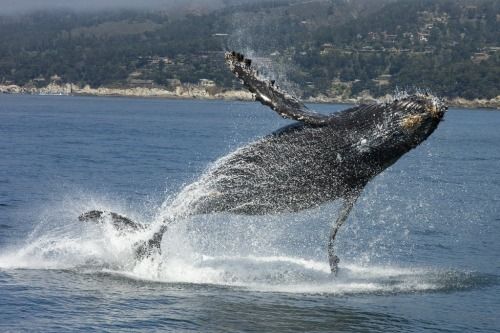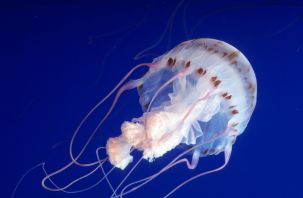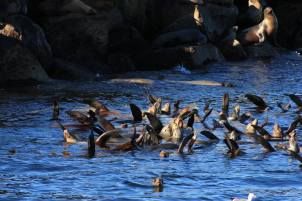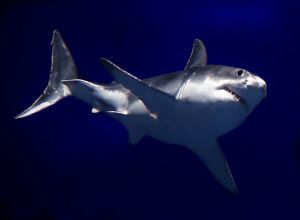California Marine Life Feeling the Heat of Climate Change

Monterey Bay is home to an astonishing array of marine life, from kelp forests to sea otters to migrating whales. The secret to its productivity: the California Current.
Monterey Bay’s rich ecosystem naturally varies in response to physical changes in the environment. But human-caused carbon dioxide emissions are driving long-term shifts that could impact fisheries and vulnerable marine species in ways we’ve never seen before.

A humpback whale breaches off the Big Sur coast. Photo ©Jim Capwell.
The California Current flows southward along the West Coast of North America delivering cool, nutrient-rich water from British Columbia to Baja California. Prevailing northwesterly winds drive the current and stimulate upwelling, a process by which cold water rises from the depths to support biodiversity off the coast.
Weird is the new normal
Life in the California Current naturally fluctuates from year to year, partially due to temperature changes, said John C. Field, a fisheries biologist with the National Oceanic and Atmospheric Administration (NOAA).

Purple-striped jellies and other gelatinous creatures sometimes dominate the California Current. The reasons are still a mystery.
In cold-water years, he says, upwelling brings nutrient-rich deep waters to the surface, typically supporting an abundance of rockfish, krill and market squid. Warm-water years, when less upwelling occurs, bring more sub-tropical species, such as pelagic red crab. Some years, jellies and other gelatinous creatures dominate the current, for reasons scientists don’t yet understand.
John participates in an ecosystem survey that monitors annual changes in marine life off the coast of California. Throughout the survey’s 33 years, he said, only one regime has dominated at a time: either a cold-water or a warm-water regime. The spring of 2015, however, was different. There were high catches of cold-water species, warm-water species, and all the gelatinous stuff.
“It was really a blend of everything,” John said. “We usually get one type of thing or the other, but nothing like this. It was a really unusual year.”
Scientists don’t know what causes weird years like this — or whether the changing climate will make them more frequent.
Fishery business
As sea surface temperatures rise, fish are getting fidgety. Scientists predict cool-water fish populations will shift farther toward the poles in the Northeast Pacific Ocean. The fish in the California Current may follow suit, said Tony Koslow, a researcher from Scripps Institution of Oceanography at the University of California, San Diego.
In a paper published last year, Tony and others found the abundance of fish in the California Current has declined dramatically for the past four decades, a trend likely driven by climate change.

Marine animals in the California Current often follow the food. Photo by Michelle Bender
The study compared two independent data sets on fish abundance in the California Current. The California Cooperative Oceanic Fisheries Investigations has collected larval fish samples since 1951, and southern California’s power plant cooling water intakes program has kept track of primarily non-commercial fish species, such as sunperch, since 1972.
The results are dramatic: Both surveys show a decline in fish abundance of more than 70 percent over the past 40 years. The biggest losses were among fish populations adapted to cool waters, such as northern anchovies, Pacific hake and rockfish.
“It shows a very strong change to the marine ecosystems off our coast,” Tony says. “Because this trend has been more or less unbroken for 40 years, it indicates climate change.”
Managing a changing sea
As we continue pumping carbon into the atmosphere by burning fossil fuels, scientists expect even more marine ecosystem scrambling. One study predicted the preferred habitats of top predators in the Pacific Ocean could shift by up to 35 percent by the year 2100.

Top ocean predators like white sharks are shifting their ranges as the sea warms.
“One of the best predictors of where top predators are concentrated in the open ocean is water temperature,” said Aquarium Research Scientist Salvador Jorgensen. “There is no question that there will be a reshuffling of species’ ranges with ocean warming.”
This could be bad news if changing conditions force vulnerable marine species out of existing protected areas. One proposed solution: employ ocean management plans that can flex based on the latest scientific data.
Connected fates
Marine animals aren’t the only creatures affected by a warming ocean. We humans are, too. For example, sea level rise increases the risk of coastal flooding, which can block roadways and damage shoreline properties. It’s just one example of how closely the ocean’s health is tied to our own.
One of the Aquarium’s partner institutions, the Center for Ocean Solutions, advocates for a nimble response. Last year, the center published a framework for bringing scientists together with Monterey Bay policymakers to create flexible management plans.
Climate change is affecting the California Current, and our coastal communities, in profound ways. But the ocean is resilient — and so are we. Working together, we can reduce carbon emissions and learn to adapt to the changes already in motion.
Learn more about our work to address the impacts of climate change on the ocean.
More Blog Posts
 Rosemary Mosco: Climate IllustrationRosemary Mosco: Climate Illustration by Allison Arteaga, March 18 2019 A comic that circulated through social media this past month spread hope on climate change to thousands, and it was all inspired by the artist’s connections to the National Network for Ocean & Climate Change Interpretation (NNOCCI). “Climate Worries”, a cartoon by science [READ MORE]
Rosemary Mosco: Climate IllustrationRosemary Mosco: Climate Illustration by Allison Arteaga, March 18 2019 A comic that circulated through social media this past month spread hope on climate change to thousands, and it was all inspired by the artist’s connections to the National Network for Ocean & Climate Change Interpretation (NNOCCI). “Climate Worries”, a cartoon by science [READ MORE] Thinking Bigger On SolutionsThinking Bigger On Solutions by Allison Arteaga, February 28 2020 We all know that we need big, systems-level change in our society in order to address climate change and create a better future. This requires high-impact collective actions that create change at the cultural and public levels by bringing people together (Frameworks). The challenge [READ MORE]
Thinking Bigger On SolutionsThinking Bigger On Solutions by Allison Arteaga, February 28 2020 We all know that we need big, systems-level change in our society in order to address climate change and create a better future. This requires high-impact collective actions that create change at the cultural and public levels by bringing people together (Frameworks). The challenge [READ MORE] The Right Message from the Right MessengerThe Right Message from the Right Messenger Allison Arteaga, December 20 2017 The National Network for Ocean & Climate Change Interpretation (NNOCCI) has some exciting news for climate change communicators! Those of you who have received training in Strategic Framing® techniques through the network may recall collecting pre- and post- training [READ MORE]
The Right Message from the Right MessengerThe Right Message from the Right Messenger Allison Arteaga, December 20 2017 The National Network for Ocean & Climate Change Interpretation (NNOCCI) has some exciting news for climate change communicators! Those of you who have received training in Strategic Framing® techniques through the network may recall collecting pre- and post- training [READ MORE] Metaphors Can Counter Misinformation about Climate ChangeMetaphors Can Counter Misinformation about Climate Change December 02 2016 This is the fifth post in a series about framing ocean and climate change. Our ability to communicate the science of climate change to the public is as important as ever. The outcome of the recent presidential and congressional elections and the state of public discourse [READ MORE]
Metaphors Can Counter Misinformation about Climate ChangeMetaphors Can Counter Misinformation about Climate Change December 02 2016 This is the fifth post in a series about framing ocean and climate change. Our ability to communicate the science of climate change to the public is as important as ever. The outcome of the recent presidential and congressional elections and the state of public discourse [READ MORE] My Community is My Hope #100HopefulDaysMy Community is My Hope #100HopefulDays Sarah-Mae Nelson, MS, CIG/CIT, February 03 2017 Today I turn 37 years old. This seems like an impossible number. In my mind, I am a vibrant 21-year-old eager to make the world a better place. I see opportunities to make a positive difference everywhere. I am young, I am empowered, and I am unstoppable. In [READ MORE]
My Community is My Hope #100HopefulDaysMy Community is My Hope #100HopefulDays Sarah-Mae Nelson, MS, CIG/CIT, February 03 2017 Today I turn 37 years old. This seems like an impossible number. In my mind, I am a vibrant 21-year-old eager to make the world a better place. I see opportunities to make a positive difference everywhere. I am young, I am empowered, and I am unstoppable. In [READ MORE]